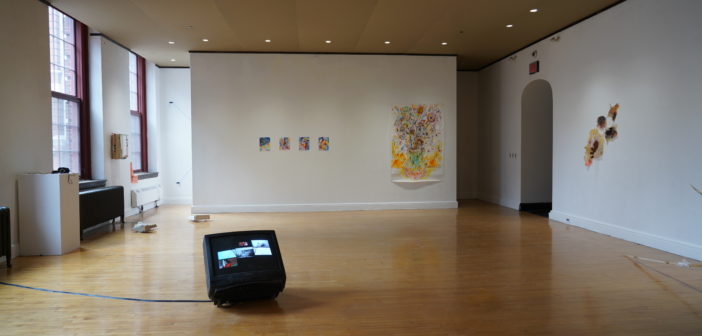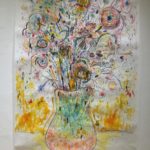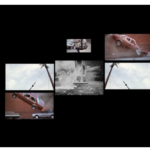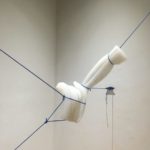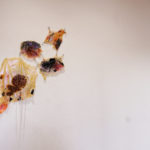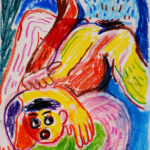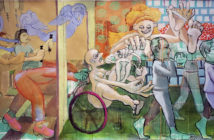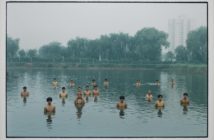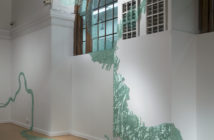The Godine Family Gallery is a student-run exhibition and project space in the Studio for Interrelated Media Department at Massachusetts College of Art and Design. The small, square space houses Perpetual Collapse, work from a selection of seven artists arranged like furniture in a casual room, where themes, colors, and shapes echo one another. From the start, it is apparent that the haphazard arrangement sets up a challenge for the viewer to connect these disparate works. True to its title, the exhibition format seems “collapsed” here, leaving pieces scattered on the floor and flung on the walls.
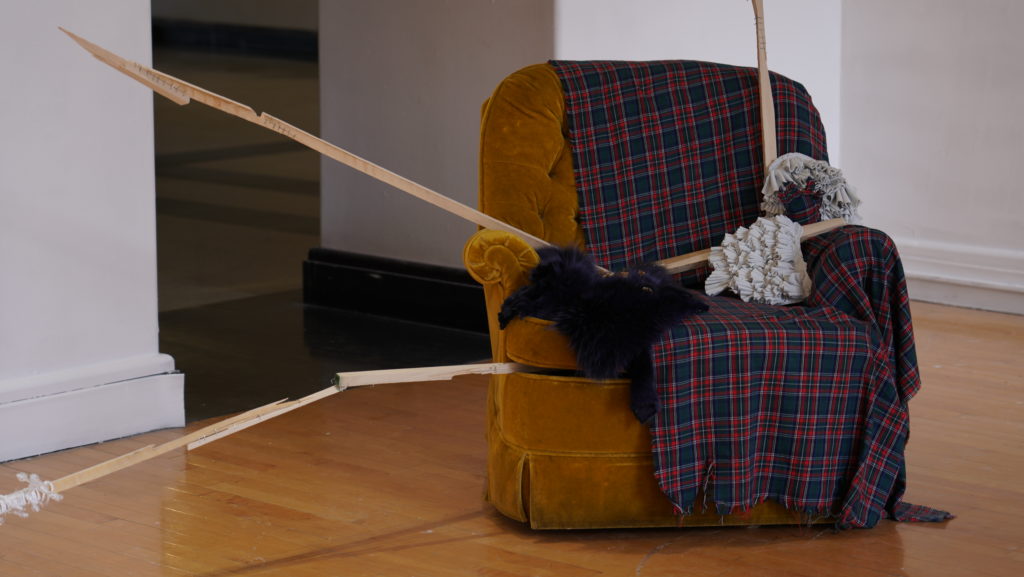
Austen Shumway, November 28, 1994
Vitrified porcelain, found wood, staples, polyester rope, pearls,
studio chair, tartan, poly-fill, fox pelts and fox gloves (poisonous)
2018
8’x6’x4’
Sopheak Sam’s soft/core series of cartoonishly sexual and emotive crayon and pastel drawings bear the same exuberant colors as Felix Kauffman’s Sunflowers. Sam Bodian’s X S T H P L, a wall-hung piece evoking chains piercing flesh, incorporates everything from pleather to fingernail clippings. Similarly diverse in material choices is Austen Shumway’s November 28, 1994, an armchair seating three dangerous-looking wooden spikes as well as fabric, fox pelts, and poisonous foxgloves. Andrew Grimanis’ 10 Juliette St (no. 4,) part of a larger series of abstract sculptures works in the show, features a rubber sculpture suggestive of a figure bound at all limbs and stretched between wall, ceiling, and floor with blue string, illustrating a physicality and freedom of material.
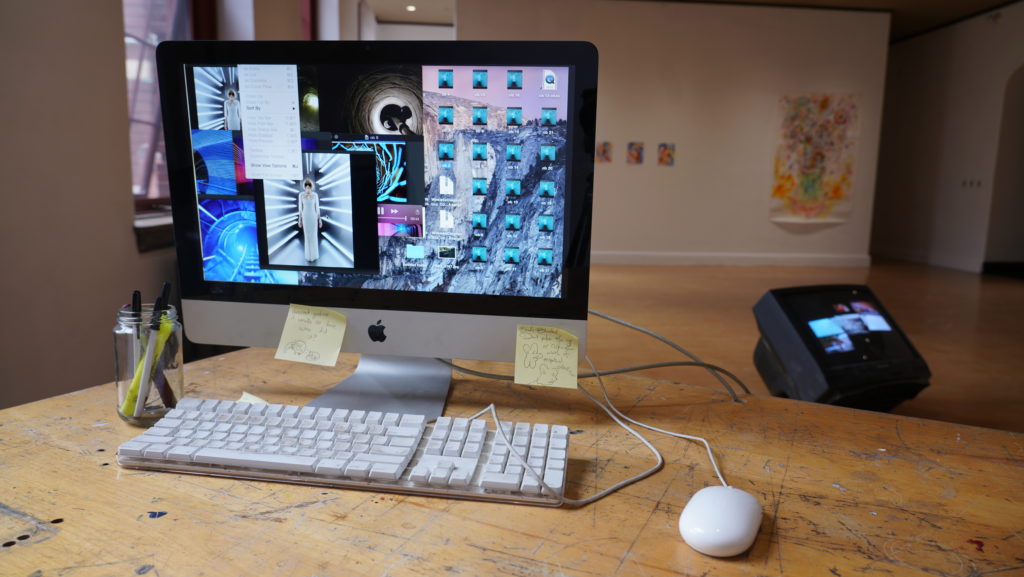
Liam Mahoney, computer break
Screen recording, google search, quicktime
10’13”
2018
Dylan Soulard’s Was sound piece, presented through headphones on a pedestal, sits quietly on the outskirts of the installation. The cover art printed in the checklist shows a crystalline, undulating pink image that matches the constantly changing nature of the sounds that run just over two minutes. Brittle percussive drops, a few guttural bars, and ethereal synths disorient the listener in what feels like a tour of an unfocused and distressed psyche. Near in proximity and of a similar theme is Liam Mahoney’s Bridges, billed as “A Theoretical Essay.” On a tilted, heavy-headed television, the viewer sees fragmented rectangles showing cars crashing and billowing gas mixed with more tranquil images of telephone poles and clear skies. Mahoney’s other piece, computer break, consists of a Mac desktop on a worn desk. A fluttering mouse queues images of blurred neon lights and looping video of cityscapes. Was, Bridges, and computer break add a frantic digital element to Perpetual Collapse that contextualizes some of the less attention-grabbing physical work in a landscape of purposeful disarray, including works that at times seem to be at various stages of completion.
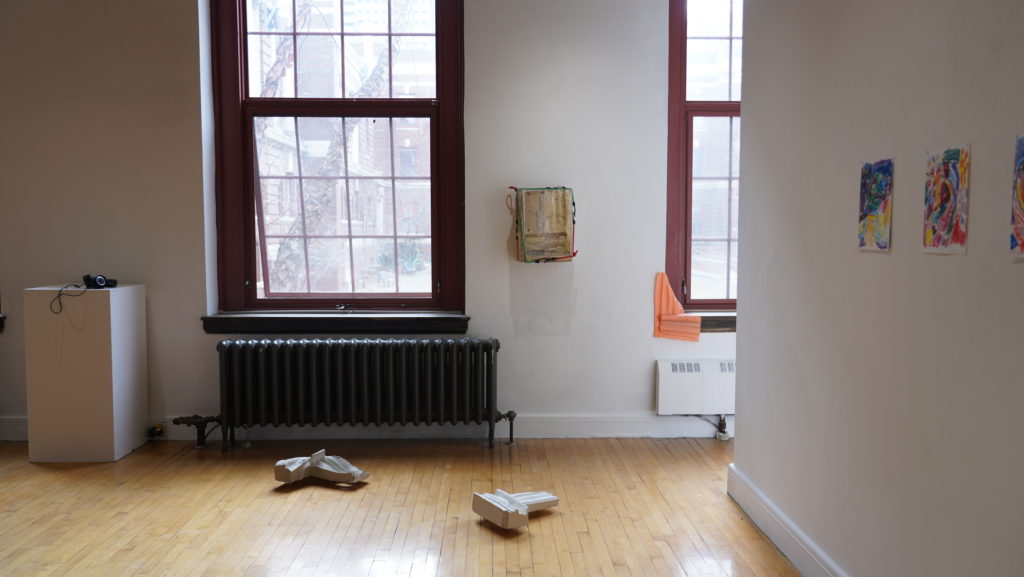
Installation view, Perpetual Collapse, Godine Family Gallery, Massachusetts College of Art and Design
I found the digital work most effective for this reason. The chaos present in Bridges and computer break felt more resonant and affecting than the sculptural works 10 Juliette St and X S T H P L, and more open to repeated and longer viewing. I wish these digital highlights were more evenly distributed around the space instead of being grouped in the corner near the entrance. Because of this layout, the work becomes less attention-grabbing as the viewer progresses through the space. The drawings and sculptures would be markedly less effective in a solo context or a more formal arrangement. Presented facing each other and requiring a circuitous path through the gallery, the dissonance becomes a harmonious open studio full of color, splayed material, and action.
- Sunflowers FELIX KAUFFMAN Mixed media 2017 47”x69”
- Bridges A Theoretical Essay LIAM MAHONEY 2018 Video, tv “How They Got There” Spike Jonze “The Big City” Solomon R. Guggenheim Museum “Bridge Collapse” Tacoma Narrows Bridge Runtime 5’11”
- 10 Juliette St (no. 4) ANDREW GRIMANIS Rubber, rope 2018
- X S T H P L SAM BODIAN Pleather, latex, o-rings, safety pins, pigment, glitter pomegranate seeds, finger nail clippings, silk 2017 2’x4’
- soft/core (no. 1) SOPHEAK SAM Crayon and pastel on paper 2017 9”x12”

